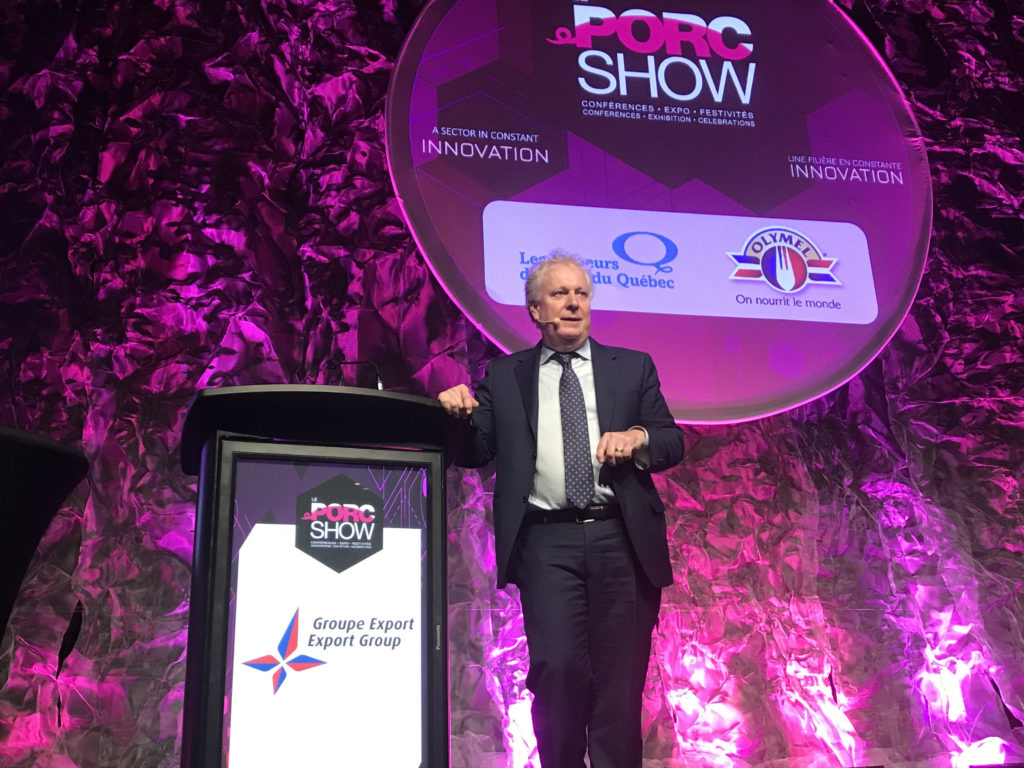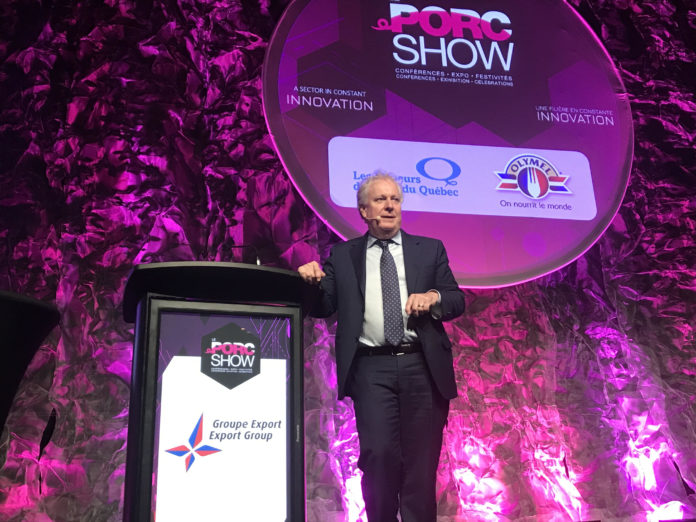By Andrew Heck

With a view of the walls of old Quebec City, and on the doorstep of the province’s National Assembly, guests from around the world gathered at the Quebec Convention Centre for The Pork Show on December 10 and 11, 2019.
Canada’s oldest major city (now more than four centuries old) might seem an unlikely location for a pork conference, but the province is our country’s top pork producer by volume, and it is here that many in the global industry are looking when it comes to innovative production and models for producer profitability.
The annual conference, now in its sixth year, is the largest pork-specific conference in Canada and routinely welcomes more than 1,000 guests from across the pork value chain to participate.
Big names and big ideas dominate the discussion

The first day of the show featured a panel discussion on African Swine Fever (ASF), with participation by Dr. Aline Dimitri, Executive Director, Animal Health, Canadian Food Inspection Agency (CFIA); Martin Pelletier, a contributor to the Quebec Swine Health Team; and Sylvain Fournaise, Vice President, Food Safety and Technical Services, Olymel.
The second day of the show was kicked off with a presentation by Jean Charest, former Quebec Premier and partner with McCarthy Tétrault LLP. He is a veteran politician with much experience on the side of trade negotiations.
In 1994, Jean Charest was chosen to lead the federal Progressive Conservative Party and in 1998, he became the leader of the Quebec Liberal Party. Charest then broke a 50-year provincial record by winning three consecutive election campaigns in 2003, 2007 and 2008. Charest helped negotiate the Canada-European Union Comprehensive Economic Trade Agreement (CETA), signed in 2016, though only partially in force, and he is currently a director with the Asia Pacific Foundation of Canada.
To Charest, there is an emerging agricultural labour crisis that has been spurred by the aging of populations in the western world, along with the rise of political populism, contrasted by a growing middle class in the developing world that is hungry for meat. Tackling these challenges is exacerbated by political tensions that underly government decision-making.

“The rise of nationalism and economic crises in some countries has changed the game forever. It’s the new reality,” said Charest. “These are warning signals. The country that moves fastest to recruit and integrate immigrants will be the one that comes out victorious. Canada is a country of immigrants, and the agriculture sector needs this.”
Brett Stuart, President, Global Agri-Trends presented a global pork market update, and Robert Saik, President, Saik Management Group presented on the future of food trends.
“Try to find a positive movie on Netflix about agriculture—you can’t,” said Saik. “We and our school-aged children are fed fear on a daily basis, and it’s affecting public perceptions of the industry.”
Guests expand their scope of knowledge
After lunch, breakout sessions were hosted on three topic areas: innovation and technology; health and livestock management; and food marketing. Each session included a half-hour presentation from two different presenters, making for a condensed but efficient format.
Breakout sessions were followed by Awards of Excellence, given to one producer and one industry partner that has demonstrated outstanding work in the past year. The awards were presented by André Lamontagne, Minister, Quebec Agriculture, Fisheries and Food and Jean Larose, Executive Director, Quebec Pork.
The winner in the producer category was Ferme Pouvaco Inc., for their efforts to improve animal welfare and environmental practices on-farm. The winner in the industry partner category was the Quebec Pork Development Centre, a centre of expertise that contributes to knowledge transfer activities and research.
To complete the formal portion of the program, Dr. Luc Dupont, Associate Professor, Faculty of Arts, University of Ottawa presented on building an effective business marketing plan, which is part of bridging the gap between public perception and the reality of pork production.
“You’re all doing wonderful things, but this is not enough; you have to tell people,” said Dr. Dupont. “If you don’t take your space, someone else will move in. You have to blow your own horn. Animal activism is a prime example of how the conversation can change shape.”
AQINAC serves Quebec’s feed grain industry

“We believe this event is an important opportunity for the entire industry,” said Sébastien Lacroix, Deputy General Director, AQINAC. “Quebec producers and partners are on the leading edge, and we want to share our expertise with guests, just as much as we want our guests to bring their great ideas to us.”
AQINAC supports more than 200 active and associated livestock and poultry feed grain members in the province, in addition to grain traders and suppliers of goods and services. The organization serves most Quebec producers involved in animal production.
The organization represents an annual production of 4.6 million tonnes of feed equivalents, which are used by more than half of all the province’s producers of hogs, poultry, turkey and eggs. This translates into more than $2 billion in feed sales. Nearly two-thirds of the total volume of Quebec grain passes through institutions that are members of AQINAC.
While the first commercial feed mills appeared in Quebec in the late 1930s, it was not until 1961 that a first group of millers was born. Originally established as the Association for the Expansion and Protection of the Agricultural Industry in Eastern Canada Inc., in 1963, the organization became the Professional Association of Quebec Millers.
In the mid-1990s, the association’s membership became more diverse when it welcomed members of the Quebec Division of the Animal Nutrition Association of Canada (ANAC). To reflect this diversity, and to mark the integration of grain traders, the organization changed its name again in 1996 to become the current AQINAC.
Quebec’s culinary excellence on display
The first evening of the conference featured networking opportunities and the presentation of research posters by Swine Innovation Porc, along with a cocktail reception featuring local beverages, in addition to pork dumplings and pulled pork sliders.
Throughout the event, guests were privileged to enjoy the best of what the province has to offer. The experience was most obvious during the plated lunch on the second day of the conference, which included cuts from the belly of a young, milk-fed pig (porcelet), served with a pepper gravy, bacon-and-cheese mashed potatoes and honey-roasted vegetables. The menu was created by a culinary team that won a competition to have their meal included in The Pork Show’s program.
The second evening of the conference again featured cocktails and networking opportunity, followed by a casual food and beverage tasting event, during which guests were invited to sample the finest of Quebec fare, including charcuterie, hot appetizers and assorted samples of wine, beer and spirits.




